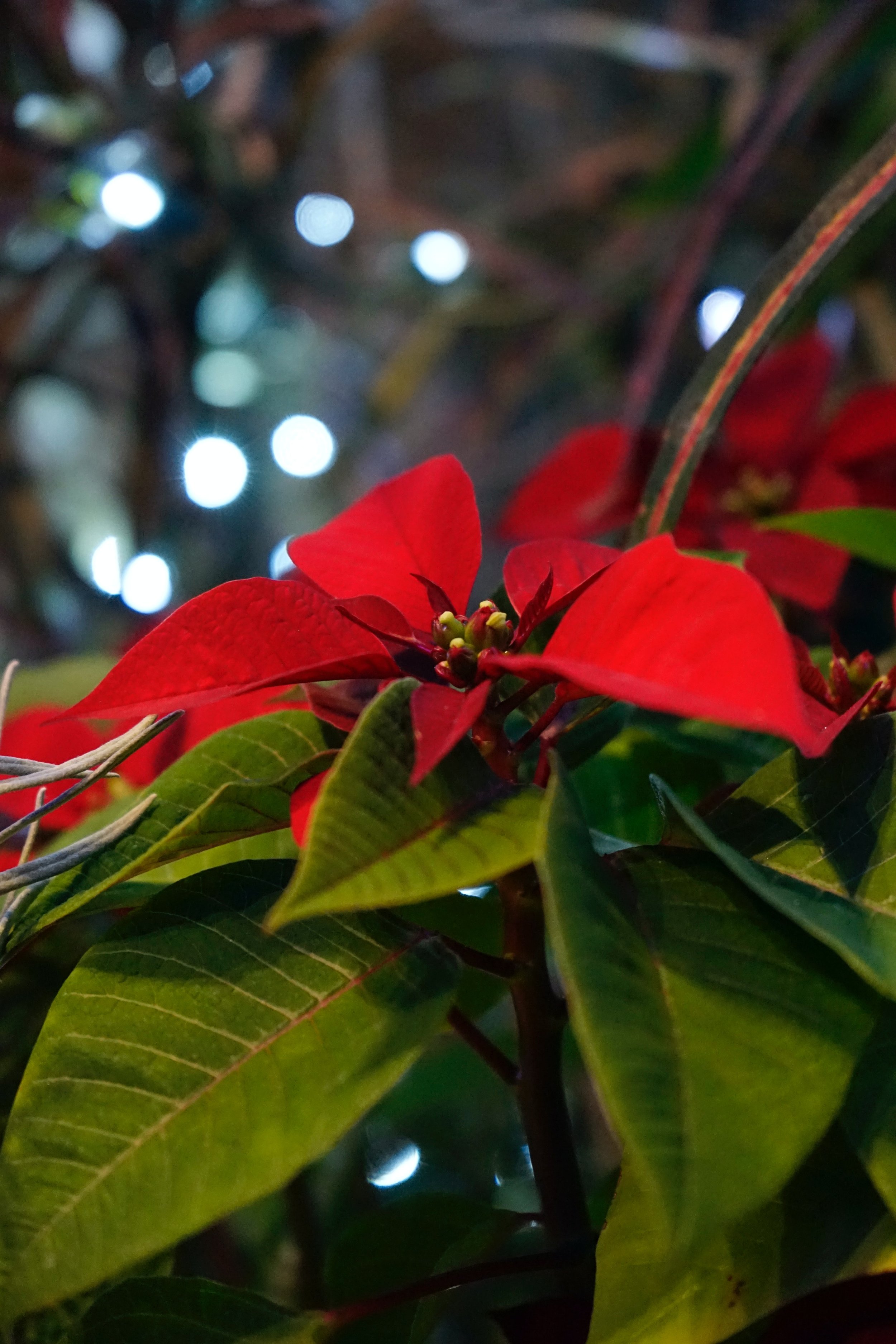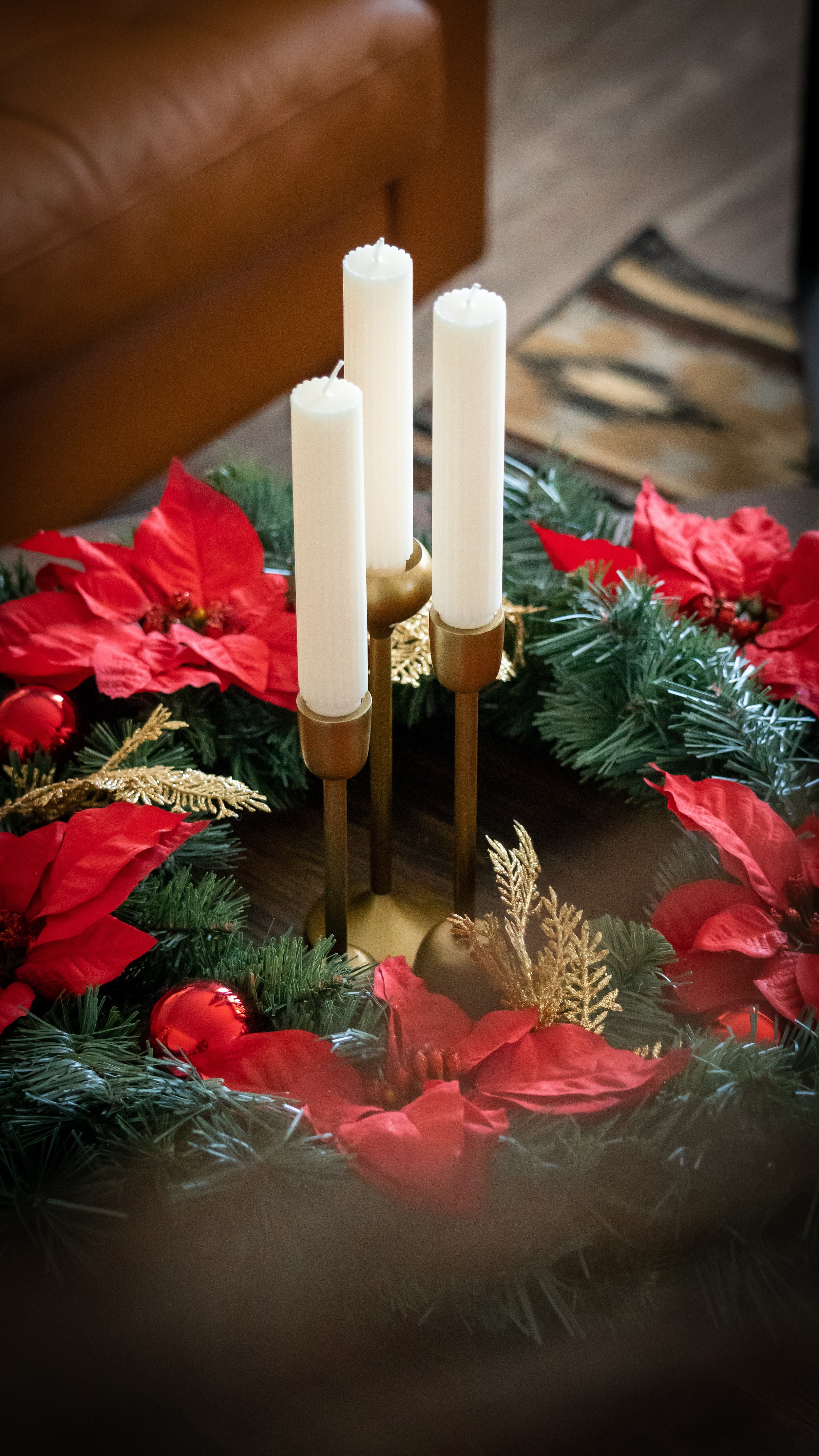Poinsettia: The Christmas Flower

Poinsettia: The Christmas Flower
There’s no denying that poinsettias make bright, festive decorations during winter months. Being native to Central America, especially an area of southern Mexico known as 'Taxco del Alarcon' where they flower during the winter. Even though we refer to them as flowers, they’re actually colourful leaves, not flowers. So why do we consider them the official Christmas flower?
There is an old Mexican legend about how Poinsettias and Christmas come together:
There was once a poor Mexican girl called Pepita who had no present to give the the baby Jesus at the Christmas Eve Services. As Pepita walked to the chapel, sadly, her cousin Pedro tried to cheer her up.
'Pepita', he said "I'm sure that even the smallest gift, given by someone who loves him will make Jesus Happy."
Pepita didn't know what she could give, so she picked a small handful of weeds from the roadside and made them into a a small bouquet. She felt embarrassed because she could only give this small present to Jesus. As she walked through the chapel to the altar, she remembered what Pedro had said. She began to feel better, knelt down and put the bouquet at the bottom of the nativity scene. Suddenly, the bouquet of weeds burst into bright red flowers, and everyone who saw them were sure they had seen a miracle. From that day on, the bright red flowers were known as the 'Flores de Noche Buena', or 'Flowers of the Holy Night'.
The shape of the poinsettia flower and leaves are sometimes thought as a symbol of the Star of Bethlehem which led the Wise Men to Jesus. The red colored leaves symbolize the blood of Christ. The white leaves represent his purity.
The poinsettia was made widely known because of a man called Joel Roberts Poinsett (that's why we call them Poinsettia). He was the first Ambassador from the USA to Mexico in 1825. Poinsett had some greenhouses on his plantations in South Carolina, and while visiting the Taxco area in 1828, he became very interested in the plants. He immediately sent some of the plants back to South Carolina, where he began growing the plants and sending them to friends and botanical gardens. One of the friends he sent plants to was John Bartram of Philadelphia. At the first Philadelphia flower show, Robert Buist, a plants-man from Pennsylvania saw the flower and he was probably the first person to have sold the poinsettias under their botanical, or latin name, name 'Euphorbia pulcherrima' (it means, 'the most beautiful Euphorbia'). They were first sold as cut flowers. It was only in the early 1900s that they were sold as whole plants for landscaping and pot plants. The Ecke family from Southern California were one of, if not, the first to sell them as whole plants and they're still the main producer of the plants in the USA. It is thought that they became known as Poinsettia in the mid 1830s when people found out who had first brought them to America from Mexico. They didn’t become traditional Christmas decorations until the entrepreneurial Ecke family started promoting them a century later.
You can buy a poinsettia plant from most supermarkets or florists through the winter season.
How to take care of your poinsettia plant:
Our top tips to extend the lifespan of poinsettias during Christmas —
A healthy poinsettia plant will have intact bracts. If the little yellow buds between the coloured bracts – the actual flowers – still look tight then you'll know that the quality of the poinsettia plant is good.
If possible, check the soil before buying. It should be neither dripping wet nor totally dry, and if it is, it's probably not been given proper TLC so might not last in your care.
Poinsettias need soil within an optimum ph range of 5.8 to 6.2, using three parts soil to one part grit, so that plenty of oxygen can reach the roots. Most poinsettias don't need repotting over winter, so you can keep it in the pot you bought it in.
When you've chosen and bought your poinsettia, make sure to wrap it up in paper for the journey home to protect it from draughts and temperatures below 12 degrees Celsius. Poinsettia is a sensitive plant, so taking this extra precaution will protect it from damage that is initially invisible but can lead to premature loss of leaves after a few days.
Poinsettias don't like a lot of water. Always remember that the plant's root bale should neither dry out nor be drenched. Overwatering can quickly lead to waterlogging, which in turn causes root rot and leaves you with a dead houseplant.
You should get into habit of inspecting its leaves. If they're turning yellow or falling off, you're probably not watering it right. Much like the case with orchids, many flower enthusiasts mean well but they often overwater poinsettias when they only really need a little.
You should water your poinsettia plant when the soil is noticeably dry. This could be every day in the case of a plant near a radiator in a dry room, or only every second or third day in other spots. How to check? Carefully lift up the plant; if it feels light, it's time to water. Mini poinsettias should be checked every day. You can also water these plants by soaking them from below, which saturates the soil more than normal watering (one dip per week should do).
Poinsettias prefer room-temperature water, and smaller pots need watering more often than big ones because they dry out faster. For a standard pot with a diameter of 13cm, give it no more than a small glass of water, i.e. around 0.2 litres; this prevents large pores in the soil from clogging up and waterlogging. Mini poinsettias should not be given more than one shot glass of water. Remove any excess water that is still in the planter after 10 minutes.
If in doubt, it's better to keep poinsettias a little drier (rather than too moist) and to water them little and often, rather than rarely but in great quantity. 'Poinsettias are particularly long-lasting when they are fertilised once a week from about four weeks after purchase, using a commercial liquid fertiliser for flowering houseplants in the dosage indicated on the packaging,' advise poinsettia experts Stars for Europe.
Remember, poinsettias like humid conditions, so keep them misted if it's in a room where the central heating is on full blast.
Poinsettias need warmth and light. It can be kept close to a radiator but it must be kept away from draughts (that means NO fireplaces, open doorways, open windows or breezy hallways). If it’s too draughty, this plant may start to lose its leaves. Try to place poinsettias in a sheltered spot.
A temperature of between 15 and 22 degrees is ideal, making these poinsettias well suited to bedrooms and living rooms. Sufficient light is important for the plant to grow and thrive (poinsettias prefer a light spot rather than full shade). The usual advice is to keep plants out of direct sunlight to protect their leaves from burning, but in the winter months this shouldn't be a problem, so it's fine to place your poinsettia plant by a south-facing window.
To ensure it survives until next year, you will need to prune the poinsettia in April to about 10cm (4in), and keep it at a temperature of 13°C. Repot in May and grow it in a cool and light place over summer, ideally at a temperature of 15-18°C.
When November comes around, it is time to start forcing the plant. It will require 12 hours of bright daylight followed by 12 hours of complete darkness to alert it to the shorter days of winter, which will encourage the red flowers to flourish.
The Arbour.

